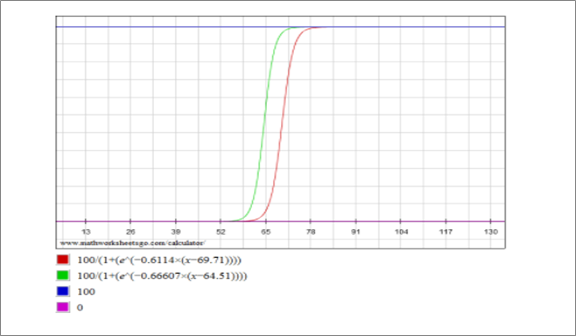
Concept explainers
a.
To graph: two functions in the same viewing window.
a.
Explanation of Solution
Given information: The percent m of American males between the age of 18 and 24
who are no more than x inches tall is modeled by:
And the percent m of American females between the age of 18 and 24who are no more
than x inches tall is modeled by:
Calculation:
Given function are
The graph of the given functions using graphing calculator is shown below.

b.
To find: the horizontal asymptotes of the function using the graph of part (a) and interpret their meanings in the context of the problem.
b.
Answer to Problem 132E
The horizontal asymptotes are:
Explanation of Solution
Calculation:
The horizontal asymptote of the function is given by substituting the value of x −axis component to
The horizontal asymptotes are:
c.
To find: the average height for each sex( male or female).
c.
Answer to Problem 132E
Average height of male is 69.71.
Average height of male is 64.51.
Explanation of Solution
Calculation:
From the graph, most males and females are bigger than 52in tall and less than 78in tall and there are no more Americans male and female more than 78 in tall.
Average height of male is 69.71.
Average height of male is 64.51.
Chapter 3 Solutions
EP PRECALC.GRAPHING APPR.-WEBASSIGN-1YR
- Let f(x, y) = 2x + 3y+ In(xy)arrow_forward(3) (16 points) Let D = [0, π/2] × [0, 7/6]. Define T: DCR2 R3 by → T(0, 4) = (2 sin cos 0, 2 sin sin 0, 2 cos x). Let S be the surface parametrized by T. (a) (8 points) Determine the normal, call it n(p), for the tangent plane TS at an arbitrary point p = T(0, 4). (b) (4 points) Show that n(p) parallel to the position vector T(0, 4) determined by p? Do the two vectors have the same direction or opposite direction? Explain. (c) (4 points) At which points p, if any, is TS parallel to the xy-plane?arrow_forward5:19 0 TEMU TEMU >>> 49 95% University at Albany - Single Sig... L Lumen OHM D2L HW4- AMAT100-Precal HW4 Score: 12.99/21 Answered: 18/21 × Question 16 Score on last try: 0 of 1 pts. See Details for more. > Next question Get a similar question You can retry this question below Find the inverse for the function k(x) = √√7x+12 k-¹(x) = Question Help: Video Message instructor Submit Question esc ||| F1 80 ୮ (x) = tarrow_forward
 Calculus: Early TranscendentalsCalculusISBN:9781285741550Author:James StewartPublisher:Cengage Learning
Calculus: Early TranscendentalsCalculusISBN:9781285741550Author:James StewartPublisher:Cengage Learning Thomas' Calculus (14th Edition)CalculusISBN:9780134438986Author:Joel R. Hass, Christopher E. Heil, Maurice D. WeirPublisher:PEARSON
Thomas' Calculus (14th Edition)CalculusISBN:9780134438986Author:Joel R. Hass, Christopher E. Heil, Maurice D. WeirPublisher:PEARSON Calculus: Early Transcendentals (3rd Edition)CalculusISBN:9780134763644Author:William L. Briggs, Lyle Cochran, Bernard Gillett, Eric SchulzPublisher:PEARSON
Calculus: Early Transcendentals (3rd Edition)CalculusISBN:9780134763644Author:William L. Briggs, Lyle Cochran, Bernard Gillett, Eric SchulzPublisher:PEARSON Calculus: Early TranscendentalsCalculusISBN:9781319050740Author:Jon Rogawski, Colin Adams, Robert FranzosaPublisher:W. H. Freeman
Calculus: Early TranscendentalsCalculusISBN:9781319050740Author:Jon Rogawski, Colin Adams, Robert FranzosaPublisher:W. H. Freeman
 Calculus: Early Transcendental FunctionsCalculusISBN:9781337552516Author:Ron Larson, Bruce H. EdwardsPublisher:Cengage Learning
Calculus: Early Transcendental FunctionsCalculusISBN:9781337552516Author:Ron Larson, Bruce H. EdwardsPublisher:Cengage Learning





